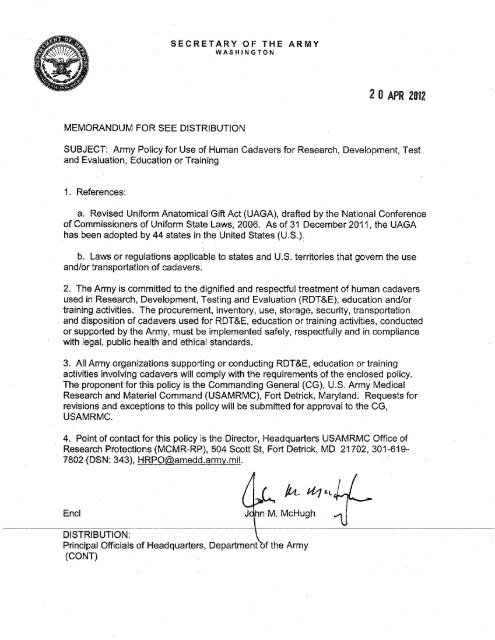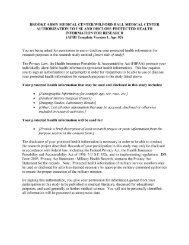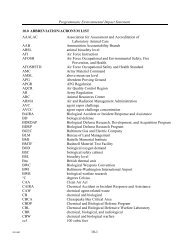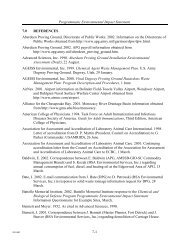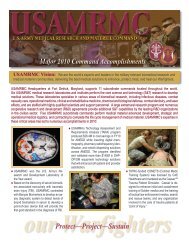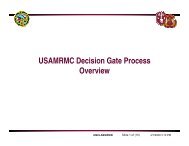20 APR 2012 - US Army Medical Research and Materiel Command
20 APR 2012 - US Army Medical Research and Materiel Command
20 APR 2012 - US Army Medical Research and Materiel Command
You also want an ePaper? Increase the reach of your titles
YUMPU automatically turns print PDFs into web optimized ePapers that Google loves.
SECRETARY OF THE ARMYWASHINGTON<strong>20</strong> <strong>APR</strong> <strong>20</strong>12MEMORANDUM FOR SEE DISTRIBUTIONSUBJECT: <strong>Army</strong> Policy for Use of Human Cadavers for <strong>Research</strong>, Development, Test<strong>and</strong> Evaluation, Education or Training1. References:a. Revised Uniform Anatomical Gift Act (UAGA), drafted by the National Conferenceof Commissioners of Uniform State Laws, <strong>20</strong>06. As of 31 December <strong>20</strong>11, the UAGAhas been adopted by 44 states in the United States (U.S.).b. Laws or regulations applicable to states <strong>and</strong> U.S. territories that govern the use<strong>and</strong>/or transportation of cadavers.2. The <strong>Army</strong> is committed to the dignified <strong>and</strong> respectful treatment of human cadaversused in <strong>Research</strong>, Development, Testing <strong>and</strong> Evaluation (RDT&E), education <strong>and</strong>/ortraining activities. The procurement, inventory, use, storage, security, transportation<strong>and</strong> disposition of cadavers used for RDT&E, education or training activities, conductedor supported by the <strong>Army</strong>, must be implemented safely, respectfully <strong>and</strong> in compliancewith legal, public health <strong>and</strong> ethical st<strong>and</strong>ards.3. All <strong>Army</strong> organizations supporting or conducting RDT&E, education or trainingactivities involving cadavers will comply with the requirements of the enclosed policy.The proponentfor this policy is the Comm<strong>and</strong>ing General (CG), U.S. <strong>Army</strong> <strong>Medical</strong><strong>Research</strong> <strong>and</strong> <strong>Materiel</strong> Comm<strong>and</strong> (<strong>US</strong>AMRMC), Fort Detrick, Maryl<strong>and</strong>. Requests forrevisions <strong>and</strong> exceptions to this policy will be submitted for approval to the CG,<strong>US</strong>AMRMC.4. Point of contact for this policy is the Director, Headquarters <strong>US</strong>AMRMC Office of<strong>Research</strong> Protections (MCMR-RP), 504 Scott St, Fort Detrick, MD 21702, 301-619-7802 (DSN: 343), HRPO@amedd.army.mil.EnclDISTRIBUTION:Principal Officials of Headquarters, Department of the <strong>Army</strong>(CONT)
SUBJECT: <strong>Army</strong> Policy for Use of Human Cadavers for <strong>Research</strong>, Development, Test<strong>and</strong> Evaluation, Education, or TrainingDISTRIBUTION: (CO NT)Comm<strong>and</strong>erU.S. <strong>Army</strong> Forces Comm<strong>and</strong>U.S. <strong>Army</strong> Training <strong>and</strong> Doctrine Comm<strong>and</strong>U.S. <strong>Army</strong> <strong>Materiel</strong> Comm<strong>and</strong>U.S. <strong>Army</strong> EuropeU.S. <strong>Army</strong> CentralU.S. <strong>Army</strong> NorthU.S. <strong>Army</strong> SouthU.S. <strong>Army</strong> PacificU.S. <strong>Army</strong> AfricaU.S. <strong>Army</strong> Special Operations Comm<strong>and</strong>Military Surface Deployment <strong>and</strong> Distribution Comm<strong>and</strong>U.S. <strong>Army</strong> Space <strong>and</strong> Missile Defense Comm<strong>and</strong>/<strong>Army</strong> Forces Strategic Comm<strong>and</strong>U.S. <strong>Army</strong> Network Enterprise Technology Comm<strong>and</strong>/9 th Signal Comm<strong>and</strong> (<strong>Army</strong>)U.S. <strong>Army</strong> <strong>Medical</strong> Comm<strong>and</strong>U.S. <strong>Army</strong> Intelligence <strong>and</strong> Security Comm<strong>and</strong>U.S. <strong>Army</strong> Criminal Investigation Comm<strong>and</strong>U.S. <strong>Army</strong> Corps of EngineersU.S. <strong>Army</strong> Military District of WashingtonU.S. <strong>Army</strong> Test <strong>and</strong> Evaluation Comm<strong>and</strong>U.S. <strong>Army</strong> Installation Management Comm<strong>and</strong>Superintendent, U.S. Military AcademyDirector; U.S. <strong>Army</strong> Acquisition Support CenterCF:Comm<strong>and</strong>er, U.S. <strong>Army</strong> Cyber Comm<strong>and</strong>Comm<strong>and</strong>er, Eighth U.S. <strong>Army</strong>Comm<strong>and</strong>er, U.S. <strong>Army</strong> Reserve Comm<strong>and</strong>Director, <strong>Army</strong> National GuardExecutive Director, <strong>Army</strong> National Cemeteries Program2
<strong>Army</strong> Policy for Use of Human Cadavers for <strong>Research</strong>, Development, Test <strong>and</strong>Evaluation (RDT&E), Education or Training1. References:a. Revised Unifonn Anatomical Gift Act (UAGA), drafted by the National Conferenceof Commissioners of Uniform State Laws, <strong>20</strong>06. As of December 31, <strong>20</strong>11, the UAGAhas been adopted by forty-four (44) states in the United States (U.S.).b. Laws or regulations applicable to states <strong>and</strong> U.S. territories that govern the use<strong>and</strong>/or transportation of cadavers.2. Applicability <strong>and</strong> Scope: The enclosed policy applies to all uses of human cadaversin Department of the <strong>Army</strong> (DA)-conducted or supported <strong>Research</strong>, Development, Test,Evaluation (RDT&E), education or training activities. This policy does not apply to othertherapeutic uses of cadavers (e.g., for organ donation, tissue transplantation or othermedical therapy) that are regulated by the U.S. Food <strong>and</strong> Drug Administration <strong>and</strong>subject to other federal laws <strong>and</strong> regulations.3. Purpose: The Anny is committed to the ethical use of human cadavers in RDT&E,education or training. This policy establishes the requirements that must be met for DAorganizations to conduct or support activities involving the use of human cadavers inRDT&E, education or training.4. Proponent: The proponent of this policy is the Comm<strong>and</strong>ing General (CG), U.S.Anny <strong>Medical</strong> <strong>Research</strong> <strong>and</strong> <strong>Materiel</strong> Comm<strong>and</strong> (<strong>US</strong>AMRMC). The Action Office forthis policy is the Headquarters (HQ) <strong>US</strong>AMRMC Office of <strong>Research</strong> Protections (ORP).5. Definitions:a. The term "cadaver" means a deceased person or portion thereof <strong>and</strong> issynonymous with the terms "human cadaver" <strong>and</strong> "post-mortem human subject" or"PMHS." The tenn includes organs, tissue, eyes, bones, arteries or other specimensobtained from an individual upon or after death. The tenn "cadaver" does not includeportions of an individual person, such as organs, tissue or blood, that were removedwhile the individual was alive (for example, if a living person donated tissue for use infuture research protocols, that tissue is not considered a "cadaver" under this policy, .regardless of whether the donor is living or deceased at the time of tissue use).b. The tenn "DA-conducted" means DA personnel are the primary personnelperfonning the RDT&E, education or training activities. The DA-conducted activity can--~o-ccurat-a-DA-or-n-on;;;OA-lo-catton.
SUBJECT: <strong>Army</strong> Policy for Use of Human Cadavers for <strong>Research</strong>, Development, Test<strong>and</strong> Evaluation, Education or Trainingc. The term "DA-supported" means the DA is providing at least some of theresources for the activity. Resources may include but are not limited to funding,facilities, equipment or personnel. In these situations the RDT&E, education or trainingactivities are primarily performed by non-DA personnel.d. The term "sensitive uses" of cadavers means RDT&E, education or trainingactivities that involve exposing cadavers to impacts, blasts, ballistics testing, crashtesting <strong>and</strong> other destructive forces.6. Responsibilities:a. The Surgeon General (TSG)/Comm<strong>and</strong>ing General, U.S. <strong>Army</strong> <strong>Medical</strong>Comm<strong>and</strong> (CG, <strong>US</strong>AMEDCOM).(1) Informs the Deputy Under Secretary of the <strong>Army</strong>; Vice Chief of Staff of the<strong>Army</strong>; Office of the Chief of Public Affairs (CPA); Chief of Legislative Liaison (CLL) <strong>and</strong>other affected HQDA Principal Officials of planned sensitive uses of cadavers in DAconductedor DA-supported RDT&E, education or training in advance of theirimplementation.(2) Informs <strong>Army</strong> leaders of major problems related to the use of cadavers inDA-conducted or DA-supported RDT&E, education or training, as appropriate. Majorproblems may include issues related to the procurement, use <strong>and</strong>/or disposition ofcadavers.(3) Distributes the annual summary of cadaver use in DA-conducted <strong>and</strong> DAsupportedRDT&E education or training to CPA <strong>and</strong> CLL.b. CG, <strong>US</strong>AMRMC.(1) May approve exceptions or waivers to this policy consistent with thecontrolling laws <strong>and</strong> regulations.(2) Forwards notifications received from HQ <strong>US</strong>AMRMC ORP of approvedsensitive uses of cadavers to TSG in accordance with (lAW) this policy.(3) Notifies TSG regarding problems related to the procurement, inventory, use,storage, transfer, transportation <strong>and</strong> dispOSition of cadavers lAW this policy.(4) Submits annual summary of activities covered by this policy to TSG.2
SUBJECT: <strong>Army</strong> Policy for Use of Human Cadavers for <strong>Research</strong>, Development, Test<strong>and</strong> Evaluation, Education or Trainingc. Director, HQ <strong>US</strong>AMRMC ORP.(1) Reviews <strong>and</strong> approves DA-conducted or DA-supported RDT&E, education ortraining activities involving sensitive uses of cadavers.(2) Notifies CG, <strong>US</strong>AMRMC of approved sensitive uses of cadavers using theStrategic Communication (STRATCOM) Summary Outline provided in Appendix A.(3) Notifies CG, <strong>US</strong>AMRMC of problems related to the procurement, inventory,use, storage, transfer, transportation <strong>and</strong> disposition of cadavers lAW this policy;(4) Ensures that DA organizations that conduct RDT&E, education or traininginvolving cadavers implement the applicable requirements outlined in this policy.(5) Implements a program of active compliance oversight of DA-conducted<strong>and</strong>/or DA-supported RDT&E,education or training that involves sensitive use ofcadavers. Annually, HQ <strong>US</strong>AMRMC will conduct a minimum of two intra- or postcompletionaudits of DA-conducted or DA-supported RDT&E, education or trainingactivities that involve the sensitive use of cadavers to assess adherence to approvedresearch <strong>and</strong>/or testing plans. Provides audit results to CG, <strong>US</strong>AMRMC, DA <strong>and</strong>civilian organizations audited.d. Comm<strong>and</strong>ers/Directors/Heads of DA Organizations conducting or supportingRDT&E, education or training activities involving the use of cadavers.(1) Ensure that the organization has policies <strong>and</strong> processes as required underParagraph 7.a. of this policy.(2) Approve all RDT&E, education or training activities involving cadavers priorto implementation.(3) Ensure that activities involving sensitive uses of cadavers comply with therequirements described in Paragraphs 7.c. <strong>and</strong> 7.d. <strong>and</strong> are submitted to HQ<strong>US</strong>AMRMC ORP for review <strong>and</strong> approval.(4) Notify HQ <strong>US</strong>AMRMC ORP if there are problems related to the procurement,inventory, use, storage, transfer, transportation <strong>and</strong> disposition of cadavers lAW thispolicy that occur during the conduct of DA-conducted or DA-supported RDT&E,------:e""ducation or training actiVities uSing me format pro\lioedln-~pp-Efn-dj)cB:-. --~--------3
SUBJECT: <strong>Army</strong> Policy for Use of Human Cadavers for <strong>Research</strong>, Development, Test<strong>and</strong> Evaluation, Education or Traininge. Principal Investigators, Test Directors, Instructors <strong>and</strong> other individualsresponsible for a DA-conducted or DA-supported RDT&E, education or training activitycovered by this policy.(1) Design, obtain review <strong>and</strong> approval of <strong>and</strong> conduct activities lAW theirapproved plans <strong>and</strong> this policy.(2) Report problems encountered in the procurement, inventory, use, storage,transfer, transportation <strong>and</strong> disposition of cadavers used for RDT&E, education ortraining to the DA organization supporting the activity.7. Policy: The procurement, inventory, use, storage, security, transportation <strong>and</strong>disposition of cadavers used for RDT&E, education or training must be conductedsafely, respectfully <strong>and</strong> in compliance with legal, public health <strong>and</strong> ethical st<strong>and</strong>ards.a. Required institutional policies. All DA organizations conducting RDT&E,education or training activities involving cadavers must have policies <strong>and</strong> proceduresgoveming cadaver use that adhere to this <strong>Army</strong> policy <strong>and</strong> applicable federal <strong>and</strong> statelaws <strong>and</strong> regulations. These policies <strong>and</strong> procedures must address, at a minimum, thefollowing:(1) Allowable cadaver use. Policies must specify the scope of DA-conducted orDA-supported RDT&E, education or training cadaver use permitted at or by theorganization. The process for obtaining organizational review <strong>and</strong> approval of eachactivity involving the use of cadavers must be described.(2) Procurement. Cadavers must be properly <strong>and</strong> legally procured. Suppliersmust be licensedlcertified if <strong>and</strong> as required by applicable law. The point of contact foracquisition <strong>and</strong> receipt of cadavers must be identified.(3) Transportation <strong>and</strong> transfer. Transportation of cadavers must comply withapplicable state <strong>and</strong> local laws <strong>and</strong> regulations. Organizations must ensure thatcadavers are properly packaged <strong>and</strong> labeled prior to <strong>and</strong> during transport.(4) Security. Cadavers must be stored in a secure location. Access to cadaversmust be limited to only authorized personnel.(5) Storage. Cadaver storage must be appropriate (e.g., temperature-controlled-------.envit(fnmant;-suitable-containmenrapparatcs};-Facilitie5,lnd-storage-condjtions-mtlst~----meet all applicable laws <strong>and</strong> regulations.4
SUBJECT: <strong>Army</strong> Policy for Use of Human Cadavers for <strong>Research</strong>, Development, Test<strong>and</strong> Evaluation, Education or Training .(6) Record-keeping. Inventories of cadavers <strong>and</strong> their location, movement <strong>and</strong>use must be tracked from the time of arrival at the DA organization until their finaldisposition, including during transfer between investigators <strong>and</strong> other Institutions.Records related to the activity (e.g., approved protocol, test p Ian or other govemingdocument; financial transactions <strong>and</strong> approval documents) must be maintained for sixyears after conclusion of the activity <strong>and</strong> may be subject to audit.(7) Disposition. Disposal of cadavers must be in a manner consistent with donorintent <strong>and</strong> legal requirements. Legal <strong>and</strong> regulatory requirements related to theh<strong>and</strong>ling of hazardous chemicals <strong>and</strong> biohazardous waste must be met, if <strong>and</strong> asapplicable.b. No procurement activities involving cadavers, whether DA-conducted or DAsupported,may occur in states that have not enacted laws at least as stringent as theUAGA.c. Review <strong>and</strong> approval of activities involving cadavers. The Comm<strong>and</strong>er/Director,or Head of a DA organization conducting or supporting RDT&E, education or trainingactivities involving cadavers, or his/her designee, must review <strong>and</strong> approve all activitieslAW this policy prior to implementation. Approval may only be granted if the followingcriteria are satisfied:(1) The use of human cadavers is necessary. Cadavers will not be used ifalternative models (e.g., manikins, simulators, etc.) are available <strong>and</strong> sufficient for theintended purpose. The benefits of the activity must be Significant enough to justify theuse of cadavers.(2) Use of the cadavers is consistent with donor intent. To assist indetermination of donor intent <strong>and</strong> ensuring use is consistent with donor intent, thePrincipal Investigator (PI), Test Director or Instructor (or other individual responsible forthe conduct of the RDT&E, education or training) will provide copies of relevant samplecadaver donation formes) <strong>and</strong> any supplemental information provided to donors (e.g.,brochures). The donation forms will be evaluated to determine if donors would havehad a reasonable expectation that their bodies could be used for activities consistentwith the contemplated use. If it is clear that a donor prohibited the contemplated use,then the donor's cadaver will not be used.(3) Protocols, test plans, programs of instruction or other governing documentsaescribin-g-the-intended-RIYf&~educatiorrortraining-activity-must-include-aetivity·~-----specific procedures for the treatment, storage <strong>and</strong> disposition of cadavers.5
SUBJECT: <strong>Army</strong> Policy for Use of Human Cadavers for <strong>Research</strong>, Development, Test<strong>and</strong> Evaluation, Education or Training. For example, the documents should describe provisions for transportation of cadaversto the activity site; security of cadavers <strong>and</strong> if/how access to cadavers is limited to onlythose personnel with a need for access <strong>and</strong> provisions for security related to the activity(e.g., limited access to the activity location).(4) Cadavers are properly <strong>and</strong> legally procured. Suppliers are licensed/certifiedif <strong>and</strong> as required by applicable law.(5) Cadavers are tested for at least Hepatitis B<strong>and</strong> HIV <strong>and</strong> any othercommunicable diseases as required by state law <strong>and</strong> Institutional policy. The PI, TestDirector, Instructor or other responsible individual will provide relevant information aboutthe results of testing for communicable diseases to the DA organization'sComm<strong>and</strong>er/Director or Head. The documentation must Indicate whether tests werepositive for any cadaver, <strong>and</strong> if so, for what diseases. The use of cadavers that testpositive for a communicable disease is not expressly prohibited; cadavers harboring acommunicable disease mayor may not be appropriate for the intended activity. Allpersonnel who may come in contact with a cadaver that tested positive for acommunicable disease must be made aware of the positive test result <strong>and</strong> anynecessary precautions to prevent disease transmission. If the PI, Test Director orInstructor believes that testing is impossible or unnecessary for a given protocol, ajustification must be provided.d. Additional requirements for approval of sensitive uses of cadavers in RDT&E,education or training. Exposures of cadavers to impacts, blasts, ballistics testing, crashtesting <strong>and</strong> other destructive activities are distinct from more conventional RDT&E,education or training uses. The need to honor donors' wishes for use(s) of donatedbodies <strong>and</strong> the often high-profile nature of such projects, necessitate additional criteriafor approval. All DA-conducted or supported RDT&E, education or training activitiesthat involve sensitive uses of cadavers must be reviewed <strong>and</strong> approved by the HQ<strong>US</strong>AMRMC ORP prior to Implementation.(1) <strong>Research</strong> protocols, test plans or programs of instruction accompanied by a .. one-page STRATCOM (see Appendix A) summary must be submitted to the Director,HQ <strong>US</strong>AMRMC ORP at least sixty (60) days in advance of the proposed start date ofthe activity involving sensitive uses of cadavers. The HQ <strong>US</strong>AMRMC ORP will reviewthe submitted materials <strong>and</strong> provide a written approval within forty-five (45) days If it Isdetermined that the requirements outlined in Paragraph 7.c (1-5) <strong>and</strong> the following.additional requirements have been met:6
SUBJECT: <strong>Army</strong> Policy for Use of Human Cadavers for <strong>Research</strong>, Development, Test<strong>and</strong> Evaluation, Education or Training(a) To be considered acceptable, the donation forms will be evaluated todetermine if donors would have had a reasonable expectation that their bodies could beused for military testing or research that involves sensitive uses. If it is clear that adonor prohibited the contemplated use, then the donor's cadaver will not be used. Thedonor language may describe only applicable specific sensitive uses or may be generic.An example of acceptable generic donor consent language is:"I underst<strong>and</strong> that my body may be used for education, research or the advancement ofmedical science <strong>and</strong> healthcare. In some cases such research <strong>and</strong>/or testing mayinvolve exposures to destructive forces, e.g., impacts, crashes, ballistic injuries, blasts.Examples of how the gift might be used include medical education <strong>and</strong> training, forensicpathology, vehicle safety or the development of protective equipment (e.g., military, lawenforcement, sports).·(b) The RDT&E, education, or training should be designed so as to minimize thepotential for psychological harm to participating staff <strong>and</strong> other personnel due to thenature of the work with human cadavers (e.g., limiting access to <strong>and</strong> visibility of theRDT&E, appropriate training of personnel <strong>and</strong> ensuring proper <strong>and</strong> respectfuldisposition of cadaver remains at the activities' conclusion).(c) The PI, Test Director or Instructor must inform personnel who will be involvedin the RDT&E, education or training activities of the intended cadaver use(s). The PIshould consider concerns or objections of the personnel, if any, involved in the work <strong>and</strong>exclude personnel without prejudice from the activity where appropriate.(d) Referrals for mental health care should be available if personnel seek suchcare because of their involvement in the RDT&E, education or training.(2) After HQ <strong>US</strong>AMRMC ORP approves the activity, the HQ <strong>US</strong>AMRMC ORPwill forward the STRATCOM summary prepared by the DA organization conducting orsupporting the activity to the CG, <strong>US</strong>AMRMC for further notification to TSG. The DAorganization may implement the activity fifteen (15) days after HQ <strong>US</strong>AMRMC ORPapproval <strong>and</strong> submission to the CG, <strong>US</strong>AMRMC unless objections are communicated tothe DA organization.e. The organizations performing the DA-supported activities must follow allapplicable laws, regulations <strong>and</strong> institutional policies/procedures related to cadaverprocurement, inventory, use, storage, security, transfer, transportation, record-keeping------'a=n=d~disposltron of cadavers.7
SUBJECT: Anny Policy for Use of Human Cadavers for <strong>Research</strong>, Development, Test<strong>and</strong> Evaluation, Education or TrainingTo ensure compliance, the HQ <strong>US</strong>AMRMC ORP <strong>and</strong> the DA organization supportingthe activity may review copies of relevant laboratory/ institution policies <strong>and</strong>/or conducton-site assessments.f. The organizations perfonning the DA-conducted or supported RDT&E, educationor training activity must adhere to the approved protocol, test plan, programs ofinstruction or other governing documents. The Comm<strong>and</strong>er/Director/Head grantingapproval, the HQ <strong>US</strong>AMRMC ORP or designees, must be pennitted to observe theactivity <strong>and</strong>/or audit activity records to ensure compliance with the approved protocol orapplicable regulatory requirements.g. Problems related to the conduct of RDT&E, education or training involving theuse of cadavers must be reported promptly to the Comm<strong>and</strong>er/Director/Head of the DAorganization conducting or supporting the activity. These may include, but are notlimited to, problems involving the procurement, Inventory, use, storage, transfer,transportation <strong>and</strong> disposition of cadavers. Examples of problems include but are notlimited to: loss of confidentiality of cadaveric donors, breach of security, significantdeviation from the approved protocol, failure to comply with state laws <strong>and</strong>/orinstitutional policies <strong>and</strong> public relations issues. The Comm<strong>and</strong>er/Director/Head mustreport to the Director, HQ <strong>US</strong>AMRMC ORP (See Appendix B) <strong>and</strong> should consult withthe Public Affairs, legal office <strong>and</strong>/or next higher Comm<strong>and</strong> level, as appropriate. TheHQ <strong>US</strong>AMRMC ORP will report the problem to the CG, <strong>US</strong>AMRMC <strong>and</strong> TSG.h. Reporting.(1) DA organizations conducting or supporting RDT&E, education or trainingactivities regulated by this policy must provide an annual summary of all activitiesconducted or supported during the calendar year to Director, HQ <strong>US</strong>AMRMC ORP (seeAppendix C). Annual reports will be submitted to the Director, HQ <strong>US</strong>AMRMC ORP by30 January of the following calendar year <strong>and</strong> include: title of the RDT&E, education ortraining activity; date the activity was conducted; identification of the DA organization'sresponsible individual (e.g., Principal Investigator or individual primarily responsible forproviding support); a brief description of the use( s) of cadavers in the activity <strong>and</strong> a briefdescription of the DA organization's involvement in the activity.(2) The Director, HQ <strong>US</strong>AMRMC ORP will prepare an annual summary ofinfonnation reported by DA organizations that conduct or support RDT&E, education or-------tt'raining;-ii1iSleportwHI-be-submittedioihe~e6~ljSAMRMe-<strong>and</strong>-'f-S6.8
SUBJECT: <strong>Army</strong> Policy for Use of Human Cadavers for <strong>Research</strong>, Development, Test<strong>and</strong> Evaluation, Education or Training8. Waivers. The DA organization supporting or conducting an activity involvingcadavers may request a waiver of this policy or a portion thereof. The request mustinclude a written' justification for the waiver <strong>and</strong> explanation of expected activityoutcomes. All waiver requests must be endorsed by the supporting or conducting DAorganization's senior legal officer <strong>and</strong> Comm<strong>and</strong>er/Director or Head. Endorsed waiverrequests will be forwarded through the DA organization's higher headquarters to theCG, <strong>US</strong>AMRMC.9. Requests for revisions <strong>and</strong> exceptions to this policy will be submitted for approval tothe CG, <strong>US</strong>AMRMC.'10. Point of contact for this policy is the Director, HQ <strong>US</strong>AMRMC ORP (MCMR-RP),504 Scott St, Fort Detrick,MD 21702,301-619-7802 (DSN: 343),HRPO@amedd.army.mil.9
APPENDIX ASTRATEGIC COMMUNICATION SUMMARYMEMORANDUM FOR Director, Headquarters, U.S. <strong>Army</strong> <strong>Medical</strong> <strong>Research</strong> <strong>and</strong><strong>Materiel</strong> Comm<strong>and</strong>, Office of <strong>Research</strong> Protections, 504 Scott St, Fort Detrick, MD21702SUBJECT: Strategic Communication Summary - Upcoming Department of <strong>Army</strong> (DA)supported or conducted RDT&E, education or training (specify one) activity that willinvolve exposing human cadavers to impacts, blasts, ballistics testing, crash testing <strong>and</strong>other destructive forces1. Purpose: The purpose of this memor<strong>and</strong>um is to inform the U.S. <strong>Army</strong> leadership ofan upcoming Department of <strong>Army</strong> (DA) supported or conducted RDT&E, education ortraining (specify which one) activity that will involve the sensitive use of humancadavers.2. Background.a. Briefly describe mission of the DA organization conducting or supporting theRDT&E, education or training activity that will involve the sensitive use of humancadavers.b. Briefly describe the DA program <strong>and</strong> nature of support RDT&E, education ortraining activity that will Involve the sensitive use of human cadavers.(1) What(2) Who(3) When(4) Where4. Talking Points (3-5 overall key messages about the RDT&E, education or trainingactivity).5. Questions <strong>and</strong> Answers (state antiCipated questions you may receive from media orexternal audiences <strong>and</strong> provide answers).10
APPENDIXBPROBLEM REPORTMEMORANDUM FOR Director, Headquarters, U.S. <strong>Army</strong> <strong>Medical</strong> <strong>Research</strong> <strong>and</strong><strong>Materiel</strong> Comm<strong>and</strong>, Office of <strong>Research</strong> Protections, 504 Scott St, Fort Detrick, MD21702SUBJECT: Problem Report - Use of cadavers in Department of <strong>Army</strong> (DA) supportedor conducted RDT&E, education or training (specify which one) activity1. Purpose: The purpose of this memor<strong>and</strong>um is to inform the Director, HQ,<strong>US</strong>AMRMC ORP of a problem related to the conduct of approved RDT&E, education ortraining (specify which one) involving human cadavers. This problem may include, butis not limited to, the procurement, inventory, use, storage, transfer, transportation <strong>and</strong>disposition of cadavers.2. Background.a. Provide information about the DA program <strong>and</strong> nature of the supported RDT&E,education or training activity that experienced the problem. Include factual details aboutthe program or specific activity such as title, assigned log number, location of theprogram or activity <strong>and</strong> local point of contact.b. Describe the problem. Include the chronology of events, pertinent factscontributing to the problem <strong>and</strong> the current status of the RDT&E, education or trainingactivity (e.g., the activity is on hold, ongoing or completed).c. Explain the actions taken as a result of the problem. Include a description ofactions taken to address, correct or resolve the problem, <strong>and</strong> any future actions that willbe taken to prevent the problem from recurring.3. Points of contact (communication, PI, etc.).11
APPENDIXC123456789101112ANNUAL SUMMARY REPORTArm Supported or Conducted Activit Involvin CadaversIn accorcJance with the <strong>Army</strong> Policy for Use of Human Cadavers for <strong>Research</strong>, Development, Test <strong>and</strong> Evaluation (RDT&E), EducalionIor Training, annualIsummary reports of, Department of Ihe<strong>Army</strong>-conducted<strong>and</strong>/or supportedI,...,..,£1"' •• ",, ... l"" •• _ ••• : .......Date(s) ~ctlvlty . Brief DescrlpUon of the Local Point of Contact for Nature of Involvement Inwas Co I ducted TlUe of the Actlvltv Cadaver Use(sj In the Activity the Actlvlli' the AcUvlli'IH ConductingS~rting;o ConductingDS~orting;I !=! ConductingDS~orting;I !=! Conductingo S~ortin.9=o ConductingDSl!IlIlOrting;I !=! Conductingo S"pportin.9=!=! Conductingo SupportinJl:!=l Conductingo SupportinQ:!=! Conductingo S~ortin.9=ConductingS~ortin.9=ConductingSupporting:o Conductingo Supporting:12


